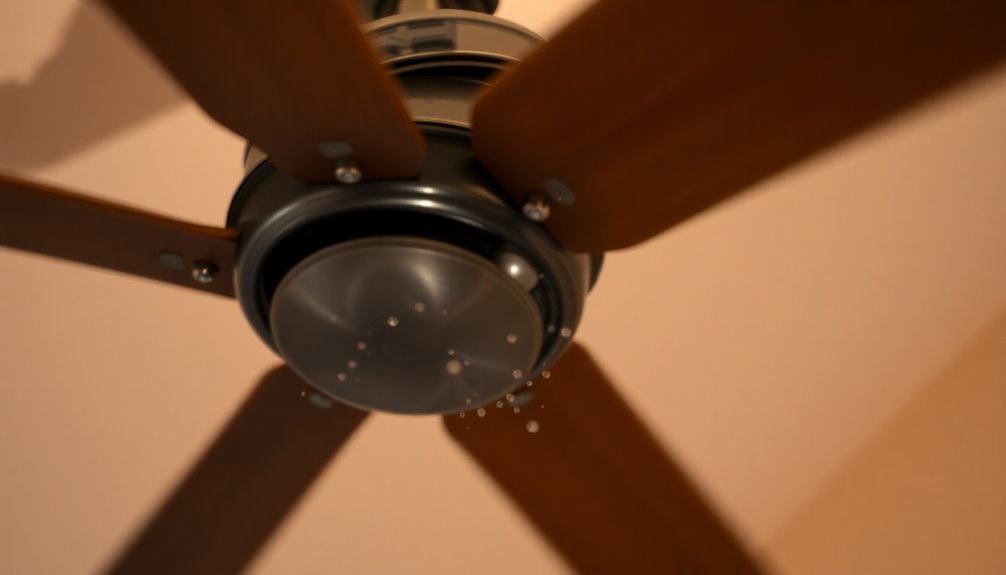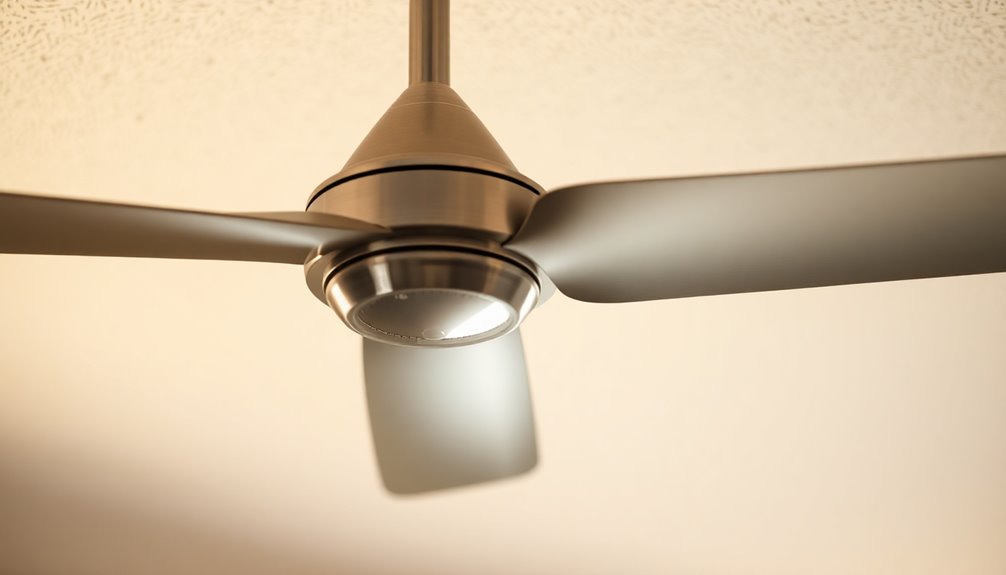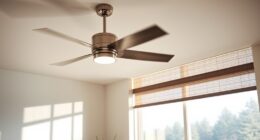Choosing the right size ceiling fan is essential for ideal airflow and comfort. You should measure your room's square footage by multiplying its length and width. Generally, larger rooms need bigger fans to maintain efficient air circulation. For standard ceilings between 8 to 9 feet, flush mount fans work best. If your ceiling is higher, contemplate using a downrod for proper installation. Confirm there's at least 8 feet of clearance between the fan blades and the floor. Selecting a fan that fits your space helps enhance your comfort and energy efficiency. There's more to reflect on for a perfect fit!
Key Takeaways
- Choose a fan size based on room dimensions; refer to a size chart for optimal airflow.
- Ensure the fan has a minimum CFM rating suitable for effective air circulation in the space.
- Maintain at least 8 feet clearance between the fan blades and floor for safety and efficiency.
- Consider downrod length for ceilings over 9 feet to enhance airflow and performance.
- Blade design and pitch also impact airflow efficiency; opt for aerodynamically shaped blades for better performance.
Measuring Room Size

When you're figuring out how big your ceiling fan should be, start by measuring your room size accurately. First, calculate the square footage by multiplying the length by the width. For instance, if your room measures 12 feet by 15 feet, that equals 180 square feet.
If your space is L-shaped, divide it into two rectangles, compute each area, and add the totals for an accurate measurement.
Next, consider the room dimensions and standard ceiling height. Most ceilings are between 8 to 9 feet high, which can influence your choice of fan and mounting options.
Accurate measurements for fans are essential for selecting ceiling fan size that guarantees ideal airflow efficiency.
Once you have the square footage and ceiling height, you can better determine the ideal fan size needed to maintain comfort in your space.
Remember, the right fan size not only improves airflow but also enhances energy efficiency.
Choosing the Right Fan Size
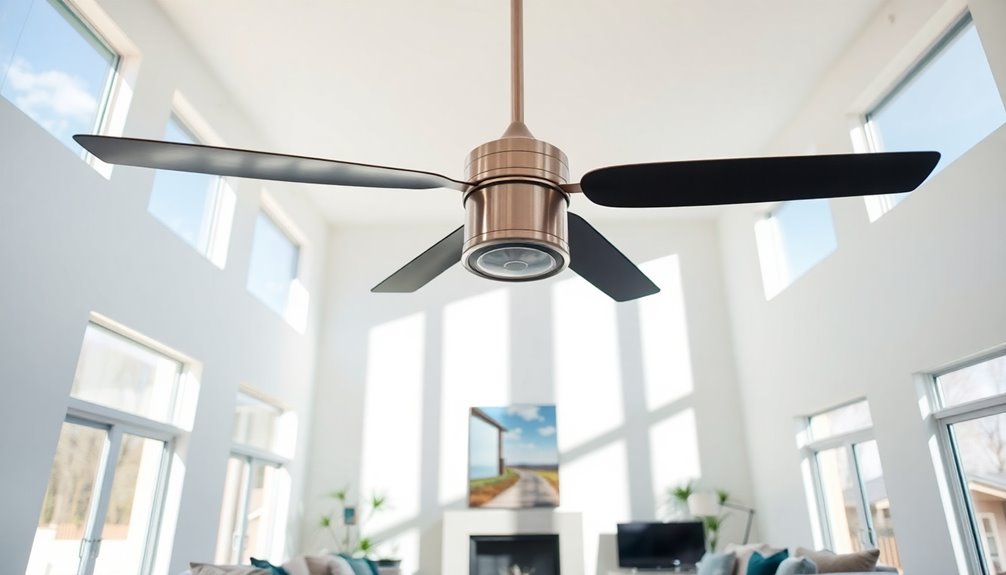
With your room size measured accurately, you're ready to choose the right ceiling fan size to match your space. The ideal ceiling fan size depends on your room size and desired air flow. A fan's blade span directly affects its ability to circulate air effectively, so make sure to take into account the CFM rating for best performance.
Here's a quick reference table for fan sizes based on room dimensions:
| Room Size (sq ft) | Fan Size (inches) | CFM Rating (minimum) |
|---|---|---|
| Up to 75 | 29-36 | 1,500 |
| 76-144 | 42 | 2,000 |
| 145-225 | 52 | 2,500 |
| 226-400 | 54-71 | 3,000 |
| Above 400 | 72+ | 4,000+ |
When choosing the right size, keep in mind the best height; fans should have at least 8 feet clearance between the blades and the floor. By carefully measuring the room and selecting the appropriate fan types, you'll guarantee comfort and efficiency in your space.
Understanding Ceiling Height
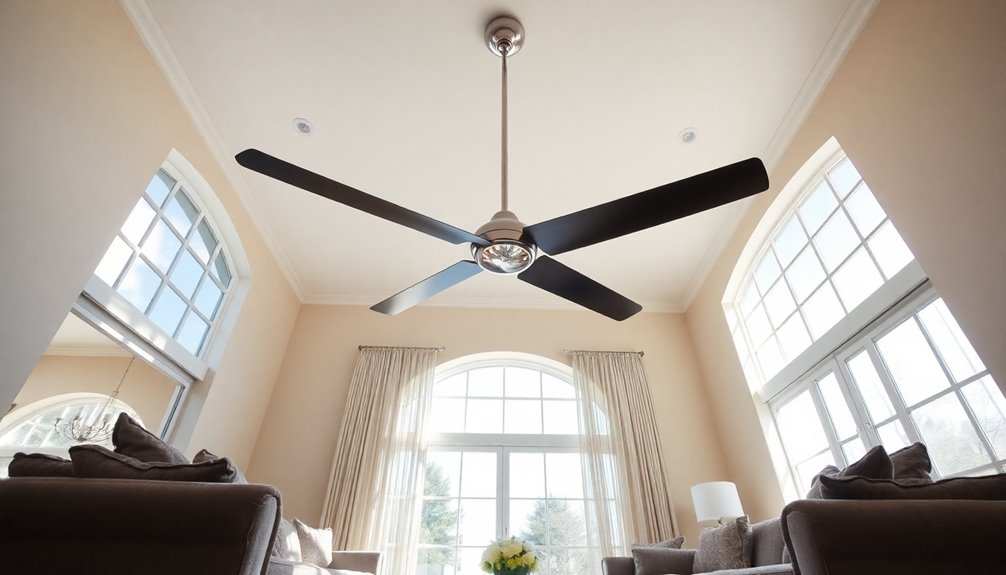
Understanding the right ceiling height is essential for the effective installation of your ceiling fan. To guarantee safety and ideal airflow, you need to take into account various factors related to your ceiling height.
- Minimum Height: Your ceiling should be at least 8 feet high, with a clearance of 7 feet above the floor for safety.
- Standard Heights: Standard ceiling heights range from 8 to 9 feet. For these heights, flush mount fans are ideal for lower ceilings, while downrod fans work best for higher ceilings.
- Downrod Use: If your ceiling exceeds 9 feet, you'll likely need downrods to lower the fan to the appropriate height for effective air circulation.
- Sloped Ceilings: For sloped ceilings, think about using angled ceiling adapters to maintain proper fan height and airflow. Additionally, consider using best air flow ceiling fans to ensure optimal cooling in rooms with varying ceiling heights.
Calculating Downrod Length
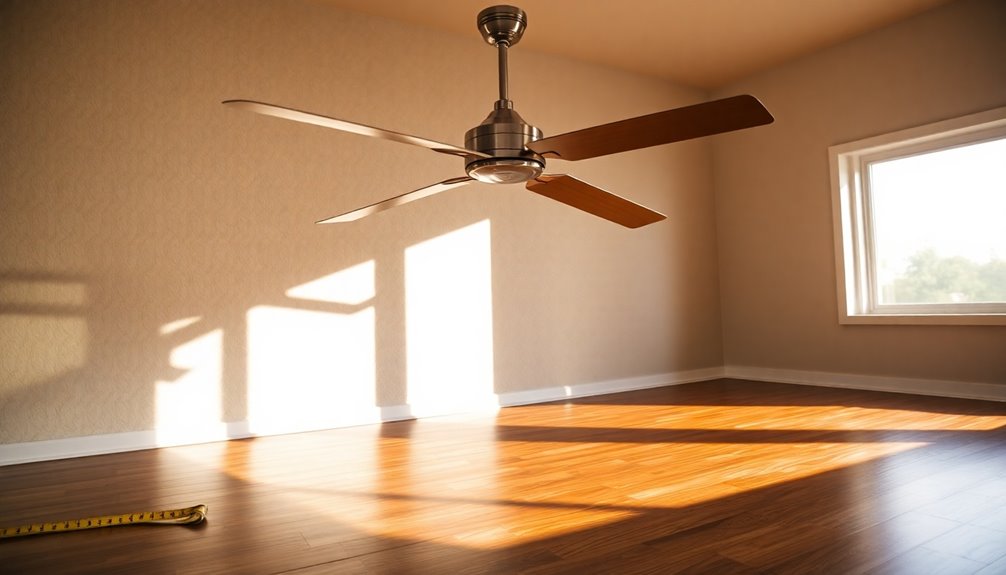
Once you've assessed your ceiling height, calculating the downrod length becomes the next step for ideal fan installation. Downrods are essential for ceilings above 9 feet to guarantee peak air circulation and fan performance. The standard fan housing height typically ranges from 8 to 12 inches, which you must consider when calculating downrod length.
To maintain a minimum clearance of 8 feet between the fan blades and the floor, you can use the following reference table for guidance:
| Ceiling Height | Recommended Downrod Length |
|---|---|
| 10 feet | 12 inches |
| 11 feet | 18 inches |
| 12 feet | 24 inches |
| 13 feet | 30 inches |
| 14 feet | 36 inches |
To calculate downrod length, measure from the tip of the fan blades to guarantee you achieve that peak clearance. This careful consideration will not only enhance safety but also maximize airflow. Proper ceiling fan installation is all about finding the right balance between height and performance for your space.
Impact of Blade Design

When choosing a ceiling fan, consider how blade design affects both efficiency and airflow.
The pitch and span of the blades play an essential role in determining how well the fan circulates air in your space.
Blade Design and Efficiency
The design of a ceiling fan's blades plays an essential role in its airflow efficiency and overall performance. When choosing a fan, you'll want to take into account several factors that affect its effectiveness in cooling or heating your space.
Here are some key points to keep in mind:
- Number of Blades: Most fans feature 4 to 5 blades. While more blades can improve air movement, it's not the only factor in efficiency.
- Blade Pitch: A higher blade pitch enhances air movement, resulting in better circulation even at lower speeds.
- Larger Blade Spans: Fans with larger blade spans can move more air quietly, ensuring effective airflow without disturbing your peace.
- Aerodynamically Shaped Blades: Selecting fans with aerodynamically shaped blades can greatly improve efficiency, leading to energy-efficient designs that help lower utility bills.
Airflow Patterns and Performance
Understanding how airflow patterns are influenced by blade design can help you make an informed choice when selecting a ceiling fan. The pitch of ceiling fan blades plays an essential role in air circulation; a higher blade pitch typically enhances airflow, even at lower speeds.
If you're dealing with larger rooms, consider fans with longer blades, ideally 52 inches or more, as they create more airflow and improve the cooling effect.
While the number of blades primarily serves aesthetic purposes, traditional 4-5 blade fans remain the most effective for air movement and performance. You should also pay attention to the CFM (cubic feet per minute) rating; fans with higher CFM deliver better air circulation and comfort.
Seasonal adjustments in blade rotation can further optimize performance. For instance, clockwise rotation can circulate warm air in winter, while counterclockwise rotation promotes cooling airflow in summer.
Ultimately, when choosing a ceiling fan, balancing blade design, pitch, size, and the number of blades will greatly impact airflow patterns and overall performance, ensuring you stay comfortable year-round.
Installation and Maintenance Tips

Before you install your ceiling fan, make certain it's at least 7 feet above the floor to guarantee safety and optimal airflow. Proper installation is essential for ideal air circulation and performance. Here are some tips to keep in mind:
- Ceiling Height: For ceilings 8-9 feet high, opt for flush mount ceiling fans. They should sit 12-14 inches from the ceiling for best results.
- Downrod Use: If your ceiling height exceeds 9 feet, use a downrod to improve air circulation. Make sure to choose the correct length based on your ceiling height.
- Clearance: Verify there's adequate clearance around the fan blades to prevent obstruction and maximize airflow.
- Regular Maintenance: Keep your fan efficient and long-lasting by regularly cleaning the blades and checking electrical connections. Regular cleaning is essential for optimal performance of your ceiling fan.
Always refer to the manufacturer's installation manual for specific guidelines and safety precautions during your ceiling fan installation.
Following these steps will help you enjoy a comfortable environment all year round while making sure your ceiling fan operates efficiently.
Frequently Asked Questions
Is a 52 Inch Fan Too Big for a 12X12 Room?
You'll find that a 52-inch ceiling fan is indeed too big for a 12×12 room.
With a space of only 144 square feet, a fan of that size can create excessive airflow, making it feel uncomfortable and drafty.
Instead, aim for a fan between 36 to 50 inches to achieve ideal airflow and maintain a balanced look.
Choosing the right size not only enhances comfort but also improves energy efficiency in your room.
How Big Should My Ceiling Fan Be for My Room?
You might think any ceiling fan will do, but choosing the right size is essential for comfort and efficiency.
For your room, first measure its square footage by multiplying length by width. If it's up to 144 square feet, a 42-inch fan works well.
For spaces from 144 to 225 square feet, opt for a 44-inch fan.
Larger areas might need a 52-inch or bigger fan to guarantee optimal airflow throughout the space.
Is It Okay to Oversize a Ceiling Fan?
It's generally not okay to oversize a ceiling fan. When you choose a fan that's too large, you might create excessive airflow, making the room uncomfortable.
Plus, it can lead to higher energy bills and strain on the fan's motor. Visually, a massive fan can disrupt your room's balance and may even need extra structural support.
Sticking to size guidelines guarantees peak performance and keeps your space feeling just right.
What Size Ceiling Fan for 14X20 Room?
For a 14×20 room, you'll want a ceiling fan with a blade span of about 52 inches.
This size guarantees ideal airflow in your 280 square foot space.
Make sure to evaluate the fan's CFM rating as well; aim for around 5,000 to 6,500 CFM for effective circulation.
If your ceiling's under 8 feet, a flush-mount fan will work best.
Always measure your room accurately to maximize comfort and efficiency.
Conclusion
In choosing the right ceiling fan, remember that size matters just like Goldilocks found her perfect fit. A fan that's too big or too small can disrupt your room's harmony, so take the time to measure and calculate. With the right blade design and downrod length, you'll create a comfortable oasis in your space. Don't forget to maintain it, ensuring your fan remains a reliable companion for years to come, just like a trusty old friend.



